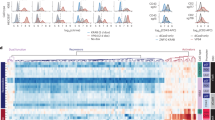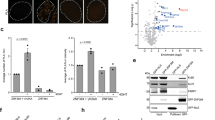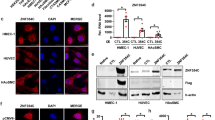Abstract
Zinc finger protein 133 (ZNF133) is composed of a Kruppel-associated box (KRAB) domain and 14 contiguous zinc finger motifs. ZNF133 is regarded as a transcriptional repressor because the KRAB domain has potent repressor activity and the zinc finger motifs usually act in binding to DNA. However, we found that the zinc finger motifs of ZNF133 also possessed transcriptional repressor activity. By two-hybrid screening assay, we found that the zinc finger motifs of ZNF133 interacted with protein inhibitor of activated STAT1 (PIAS1). PIAS1 enhanced the transcriptional repression activity of ZNF133 through the zinc finger motifs. This effect of PIAS1 was relieved by an inhibitor of the histone deacetylases (HDACs). These results demonstrate that the transcriptional repressor activity of ZNF133 is regulated by both the KRAB domain and the zinc finger motifs, and that the repressive effect by zinc finger motifs is mediated by PIAS1.
Similar content being viewed by others
Article PDF
Author information
Authors and Affiliations
Rights and permissions
This is an Open Access article distributed under the terms of the Creative Commons Attribution Non-Commercial License (http://creativecommons.org/licenses/by-nc/3.0/) which permits unrestricted non-commercial use, distribution, and reproduction in any medium, provided the original work is properly cited.
About this article
Cite this article
Lee, SJ., Lee, JR., Hah, HS. et al. PIAS1 interacts with the KRAB zinc finger protein, ZNF133, via zinc finger motifs and regulates its transcriptional activity. Exp Mol Med 39, 450–457 (2007). https://doi.org/10.1038/emm.2007.49
Published:
Issue date:
DOI: https://doi.org/10.1038/emm.2007.49
Keywords
This article is cited by
-
The conserved ancient role of chordate PIAS as a multilevel repressor of the NF-κB pathway
Scientific Reports (2017)
-
Cytogenetic characterization of HB2 epithelial cells from the human breast
In Vitro Cellular & Developmental Biology - Animal (2014)



